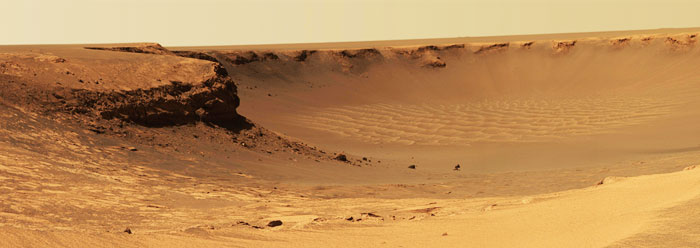On August 7, NASA announced that it had "found evidence that strongly suggests primitive life may have existed on Mars more than 3.6 billion years ago" (NASA press release).
A meteorite discovered in Antarctica in 1984, which is thought to have come from Mars, was analyzed. A team of NASA and Stanford scientists found "organic molecules thought to be of Martian origin; several mineral features characteristic of biological activity; and possible microscopic fossils of primitive, bacteria-like organisms." The individual finds were by themselves not thought to be very significant, but all of them together led NASA to make the announcement. The findings were released prior to the publication of the complete paper printed in the August 16 issue of the journal Science. This article was written after the announcement, but before the paper and can only comment on the reports.
First, let's review the claims. The meteorite is an igneous rock, said to have a mineral makeup unique to Mars, and was extensively fractured. Mars is thought to have possessed liquid water then, which seeped into the cracks, carrying with it carbon dioxide from the atmosphere. About a billion years later, simple life had evolved from non-living chemicals, and precipitated carbonate minerals and organic compounds. Some of these tiny micro-organisms became fossilized, attached to the rock. When a large comet or meteorite struck Mars, some 16 million years ago, it ejected this rock out in space where it floated in a total vacuum until 13,000 years ago when it entered earth's atmosphere as a fireball, landing in Antarctica.
A nice story, but is it true? Let's look at several features, separating the precise and presumably accurate scientific observations from the interpretations reported by the press.
(1) How does anyone know what Martian rocks are made of? The Viking Lander in 1976 radioed back some chemical data, but not enough to uniquely identify Martian rocks. Every igneous rock on earth is different, so why would Martian rocks be uniquely similar?
(2) Are these dates correct? Radioisotope dating methods are notoriously unreliable. In the meteorite named Allende—the most dated rock on earth—each mineral in it gave a different date. No confidence can be placed in the 4.5 billion, 3.6 billion, 16 million, or 13 thousand year reported ages.
(3) Could a cometory impact send rocks out into space, overcoming Mars' gravitational pull? The physics of this is possible, but tenuous. One must have good evidence before proposing such a long shot.
(4) Could organic chemicals have resisted vaporization for 16 million years in a total vacuum? Could they have survived entry through earth's atmosphere? Has there been no contamination in 13,000 years? Are these carbonaceous compounds, which are similar to those having inorganic sources, truly organic?
(5) Are the "fossils" really fossils? They are extremely tiny, "about 1/1000 the diameter of a human hair." Is the grain size of the meteorite able to preserve such fine structures?
NASA had previously scheduled another space probe to Mars in November 1996. President Clinton was briefed the week before the August 7 announcement and called for a planning session and additional funding.
As you might imagine, the media is making more of this story than the more cautious scientists, many of whom disagree. The desperate effort to prove evolution without God overrides the logic of many. I predict that soon scientists will refute this idea. In the meantime, know that Christianity is not in question.
* Dr. Morris is President of the Institute for Creation Research.
Cite this article: Morris, J. 1996. Did NASA Find Life in Martian Rocks? Acts & Facts. 25 (9).




